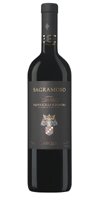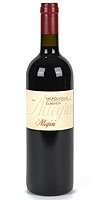Patience pays off for this Italian wine: Pasqua Sagramoso Valpolicella Superiore Ripasso 2003

I probably sound like a broken record by now but here is wine that is definitely better the second night. Pasqua Sagramoso Valpolicella Superiore Ripasso 2003 is delicious after 24 hours! Valpolicellas often do benefit from aeration. I decanted half of the bottle and then later that night recorked the remainder in a mini-bottle. This allowed it to better develop flavours like rich ripe plum at the peak of its season coated in a spicy and savoury juice of fresh fieldberries and mixed with candied figs. Harmonious, balanced and engaging.
It really doesn't make a false note, while in its initial hours of consumption it seemed a bit less integrated, a bit more challenging and green. After a generous decanting (if you're serving the entire bottle at once rather than patiently waiting for the next day like I did, allow for two to three hours in a carafe) the intensity of young fruit cedes some ground to notes of well-worn leather. Any sourness on the palate becomes bittersweet.
Pasqua Sagramoso is a distinctive Valpolicella wine that uses the ripasso method. The producer explains that vinification process on its site.
AUTHENTIC PAIRING IDEAS
A friend of mine who once traveled to Italy thought the most striking thing about how Italians do dinner is their tepid approach. Dishes served in restaurants are never served hot out of the kitchen. Grilled vegetables have come to room temperature, cooked meat has had time to rest, and cherry tomatoes -- let those stew in the balsamic and oil dressing a good while before bringing them to the table.
So for an Italian wine that clearly benefits from a good breather like this one does, I would suggest dishes that you make ahead and then let sit for a bit (handy if you are entertaining guests or for summer cooking when you want to prepare ahead to avoid the peak late-afternoon heat):
Grilled zucchini steeped in a marjoram and lemon mixture, grape tomatoes baked in the oven and removed from the heat to let expand and contract...
Broccoli blanched until it gets a vivid shade of green and then left to mingle with a sprinkling of crushed fennel seeds and some oil and garlic...
An escalope of chicken in a marinade that gets tastier and more flavourful with every passing moment...
Patience!
Illasi, Verona, Italia. 13.5%.







